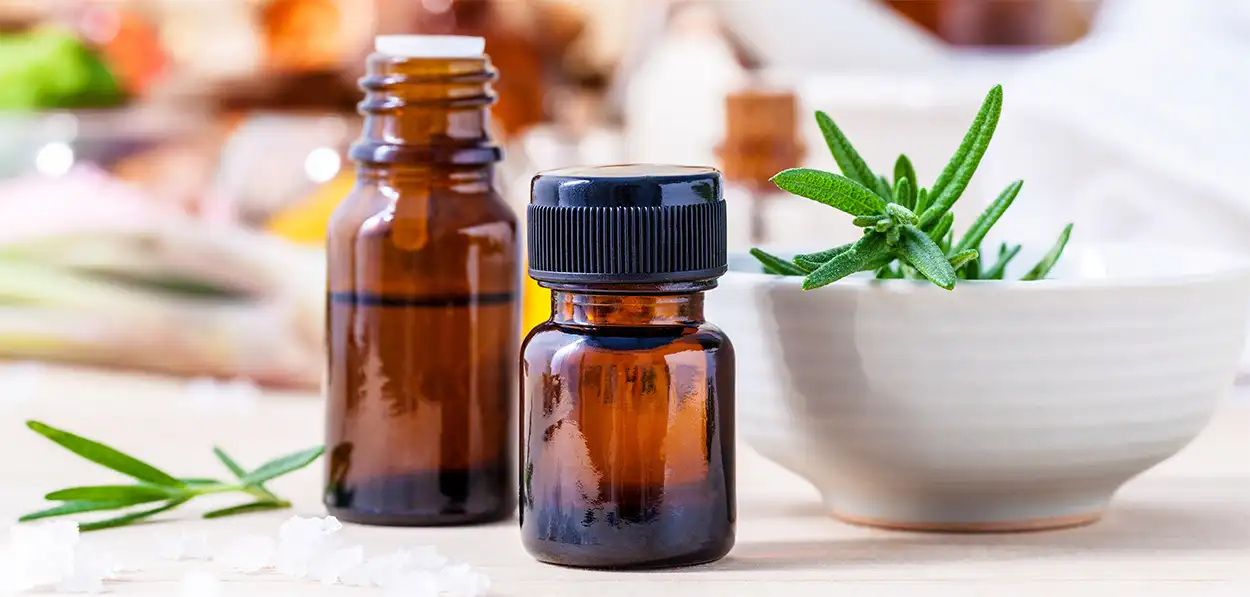The Difference Between Essential Oils and Aromatherapy Explained

Aromatherapy
As defined as simply as possible within AromaWeb's What is Aromatherapy? article, the practice of aromatherapy is a wellness modality that entails the mindful and careful use of essential oils for physical, emotional and spiritual well-being.
Essential Oils
Essential oils are highly concentrated, natural plant-based aromatic liquids that offer a wealth of benefits.
As mentioned above, essential oils are the primary aromatic used within the field of aromatherapy.
Essential oils aren't only used within the scope of aromatherapy. They are also used in skin care, perfumery applications, household cleaning applications and in countless other applications and fields.
Pure essential oils are distilled from aromatic plants. They contain no added substances and have not been modified. Citrus rind essential oils such as Sweet Orange, Lemon and Bergamot are either distilled or cold pressed from the rinds of the fruits. If an aromatic fluid was produced by any other method, it is not a pure essential oil.
AromaWeb's detailed What are Essential Oils? article provides a much more in-depth explanation of essential oils. AromaWeb also features over 130 individual essential oil profiles.
Other Ingredients Used in Aromatherapy
Other aromatic ingredients that are also utilized in aromatherapy include Absolutes, CO2 Extracts and Hydrosols.
Vegetable oils, also known as carrier oils, are also used in aromatherapy to properly dilute essential oils, absolutes and CO2 extracts so they can be safely applied to the skin. Vegetable oils, however, are fatty oils and their composition is different than that of essential oils, absolutes and CO2 extracts.
Aromatherapy Oils
The term aromatherapy oils is an ambiguous term. Be very careful when shopping with any seller that defines his/her/their oils as aromatherapy oils. Read AromaWeb's What are Aromatherapy Oils? article for a detailed explanation.
Aromatherapy Products and Blends
You may come upon the terms aromatherapy product and aromatherapy blend. Generally speaking, these terms are intended to indicate products and aromatic blends that include essential oils and that are intended for use within the scope of aromatherapy.
However, some less-than-knowledgeable companies use the term aromatherapy for products that include synthetic fragrance oils instead of essential oils, so it's always best to take a close look at the ingredients used in products that you are considering purchasing.
For More Information About Aromatherapy and the Ingredients Used
For more information, explore these areas on AromaWeb:
- Essential Oil and Aromatherapy Introductory Guides and Articles
- Guide to Essential Oils, CO2 Extracts, Absolutes and Other Beneficial Aromatic Ingredients
- Essential Oil Safety Guide
- 130 Essential Oil Profiles Uses and Benefits
- Carrier Oil Properties and Profiles
General Safety Information
Do not take any oils internally and do not apply undiluted essential oils, absolutes, CO2s or other concentrated essences onto the skin without advanced essential oil knowledge or consultation from a qualified aromatherapy practitioner. For general dilution information, read AromaWeb's Guide to Diluting Essential Oils. If you are pregnant, epileptic, have liver damage, have cancer, or have any other medical problem, use oils only under the proper guidance of a qualified aromatherapy practitioner. Use extreme caution when using oils with children and be sure to first read the recommended dilution ratios for children. Consult a qualified aromatherapy practitioner before using oils with children, the elderly, if you have medical issues or are taking medications. Before using this or any essential oil, carefully read AromaWeb's Essential Oil Safety Information page. For in-depth information on oil safety issues, read Essential Oil Safety by Robert Tisserand and Rodney Young.
Shelf Life
Important Information About the Profiles
The essential oil information provided on AromaWeb is intended for basic educational purposes only. The references to safety information, test results, constituents and percentages is generalized information. Essential oils can vary greatly in composition. The data is not necessary complete and is not guaranteed to be accurate. The essential oil photos are intended to represent the typical and approximate color of each essential oil. However, essential oil composition and color can vary based on harvesting, distillation, age of the essential oil and other factors. Profiles for several CO2 Extracts and absolutes are included within the directory, and are denoted as such.
